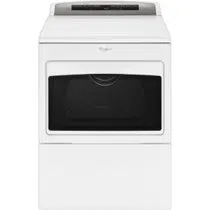Documents: Go to download!
User Manual
- User Manual - (English, French)
- Quick Start Guide - (English)
- Ventilation Specification - (English)
- Specification Sheet - (English)
- Installation Instruction - (English)
Use & Care Guide Electronic Dryer
Control Panel and Features

NOTE: The control panel features a sensitive surface that responds to a light touch of your finger. To ensure your selections are registered, touch the control panel with your finger tip, not your fingernail. When selecting a setting or option, simply touch its name.
- POWER
Touch to turn the dryer on and off. Touch to stop/cancel a cycle at any time. - WHAT TO DRY/HOW TO DRY
First select a cycle from the “What to Dry” (automatic cycles) and then select the “How to Dry” to get the best combination cycle available for the type of items you are going to dry. See the “Cycle Guide” chart for cycle details. - START/PAUSE
Touch and hold until the LED comes on to start a cycle, or touch once while a cycle is in process to pause it. - MODIFIERS
Use to select available modifiers for your dryer.
Temperature
See other models: WED4950HW WGD92HEFBD WED4985EW WGD4850HW WTW4715EW
When using a Timed Dry cycle, you may select a dry temperature based on the type of load you are drying, except for the Sanitize cycle. Use the warmest setting safe for the garments in the load. Follow garment label instructions.
NOTE: automatic cycles will give you up to three temperatures to adjust and it varies, depending on the “What to Dry” or “How to Dry” selections that have been made.
Dryness
You may adjust the Dryness on automatic cycles (except for the Sanitize cycle), if desired.
NOTE: Dryness is for use with automatic cycles only.
+\- Timed Dry Adjust
Touch “+” or “–” with a Timed Dry cycle to increase or decrease the length of the cycle. - SANITIZE
This is a long cycle with high heat, that has been proven to reduce household bacteria. This cycle is not recommended for all fabrics. Use for loads of heavyweight fabrics. - LED DISPLAY
When you select a cycle, its default settings will light up and the estimated time remaining (for automatic cycles) will vary depending on “What to Dry” and “How to Dry” selections or actual time remaining for Timed Dry cycles (for manual cycles) will be displayed. - OPTIONS
Use to select available options for your dryer.
Drum Light
Select Drum Light to turn on the light inside the dryer drum. When touched during a cycle, or when the dryer is not running, the Drum Light turns on and will remain on until Drum Light is touched again, the door is opened and closed, a cycle is started, or the door is left open for 5 minutes.
Touch Drum Light at any time to turn the drum light on or off.
Wrinkle Shield™
If you will be unable to remove a load immediately, touch Wrinkle Shield ™ to add up to 150 minutes of periodic tumbling to help reduce wrinkling.
Signal
Use this to turn the signal indicating the end of a drying cycle to low, high, or off. The volume you select here will also be applied to the Damp Dry Signal.
NOTE: You may also turn off the tones that sound when a feature, setting, or option is touched. Touch and hold Signal for about 3 seconds to turn sounds to low, high, or off.
Damp Dry Signal
Touch to select the Damp Dry Signal. The volume will be the same sound level as the “Signal” option indicates. When selected, a series of beeps will sound when the load is damp, but not completely dry. This will allow you to take clothes out of the load that do not need to dry completely. This option is available on some cycles. The Damp Dry Signal is selected as a default for the Bedding/Bulky cycle, as a reminder to manually reposition bulky loads midway through the cycle.
Cycle Guide
The Whirlpool ® dryer has a unique user interface to help you select the best cycle you need for your load. The “What to Dry”/ “How to Dry” layout guides you to the optimal cycle in two easy steps:
First determine what items are in the load that you are trying to dry. Use that to guide your “What to Dry” selection. Then determine how you want the dryer to dry them by selecting the appropriate “How to Dry” selection.
To get the most energy savings and enhanced fabric care from your dryer, use the automatic cycles. These cycles measure the drying air temperature and moisture levels to turn the dryer off once the load reaches the selected dryness level. Dryer performance and results may vary with service voltage less than 240.

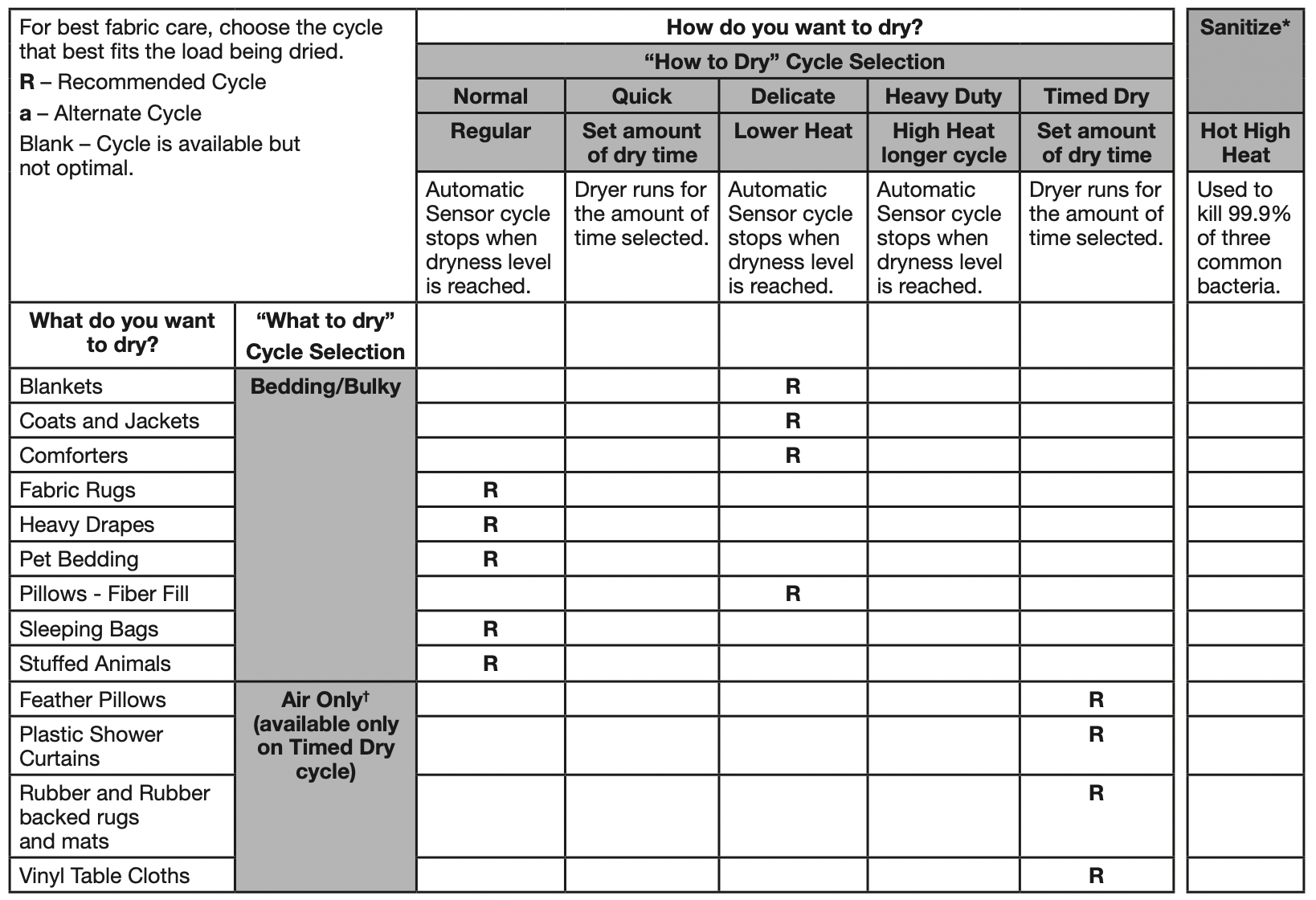
*Extended high-heat drying cycle intended to help sanitize items such as sheets and towels. This cycle is not recommended for all fabrics. For best results, this cycle should be run to completion without interruption to ensure sanitization.
† Air Only is not a “What to Dry” cycle selection. To get Air Only, select Timed Dry and set Temperature to No Heat.
NOTE: Government energy certifications for this model were based on the Cotton / Timed Dry cycle with the Maximum temperature setting. The as - shipped defaults of Cottons / Normal cycle, Temperature setting of four out of five dots, Dryness level setting of three out of four dots, and wrinkle shield were not used.
Using Your Dryer
WARNING - Explosion Hazard:
- Keep flammable materials and vapors, such as gasoline, away from dryer.
- Do not dry anything that has ever had anything flammable on it (even after washing).
- Failure to follow these instructions can result in death, explosion, or fire.
WARNING - Fire Hazard:
- No washer can completely remove oil.
- Do not dry anything that has ever had any type of oil on it (including cooking oils).
- Items containing foam, rubber, or plastic must be dried on a clothesline or by using an Air Cycle.
- Failure to follow these instructions can result in death or fire.
WARNING: To reduce the risk of fire, electric shock, or injury to persons, read the IMPORTANT SAFETY INSTRUCTIONS before operating this appliance.
- Clean the lint screen

Clean the lint screen before each load. Pull the lint screen out of its holder. Roll lint off the screen with your fingers. Do not rinse or wash screen to remove lint. Push the lint screen firmly back into place.
For additional cleaning information, see “Dryer Care.” - Load the dryer
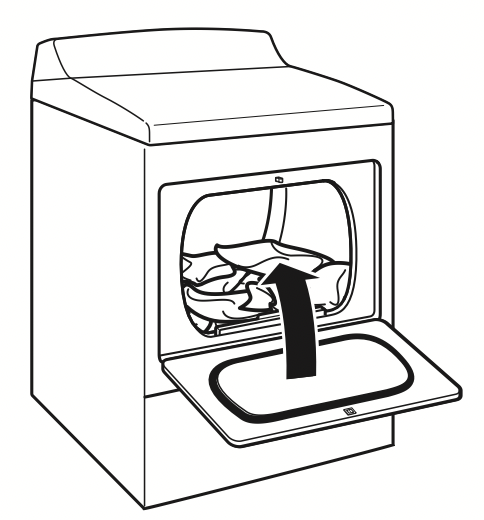
Open the door by pulling on the handle. Place laundry in the dryer. Add a dryer sheet to the wet load, if desired. Close the door.
IMPORTANT: Do not tightly pack the dryer. Items need to tumble freely. Tightly packing can lead to poor drying performance and may increase wrinkling and tangling. - Touch POWER
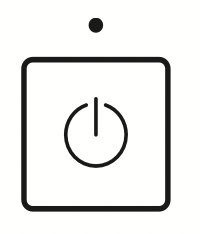
Touch POWER to turn on the dryer. - Select type of load to dry

First select a cycle from “What to Dry” (Automatic cycles) and then select “How to Dry” to get the best combination cycle available for the type of items you are going to dry. You may also select the Sanitize cycle for a long, high-heat cycle which has been proven to reduce household bacteria. The Sanitize cycle overrides previous selections and cannot be modified. See the “Cycle Guide” chart for cycle details. Not all cycles are available on all models.
Automatic Cycles:
You can select a different dryness level depending on your load. Touch DRYNESS to scroll from Less to More. Selecting Less to More automatically adjusts the dryness level at which the dryer will shut off. Dryness level can be changed in the first 5-8 minutes of the cycle.
Automatic cycles give the best drying in the shortest time. Drying time varies based on fabric type, load size, and dryness setting.
NOTE: Automatic cycles will give you up to three temperatures to adjust and it varies, depending on the “What to Dry” or “How to Dry” selections that have been made.
TIMED DRY Cycle:
When you select Timed Dry, the default time appears in the display. Touch “+” and “–” to increase or decrease the time in 1 minute increments. Touch and hold to change the time in 5 minute increments.
The default temperature may be changed by touching Temperature until the desired dry temperature is lit. - Adjust cycle modifiers, if desired
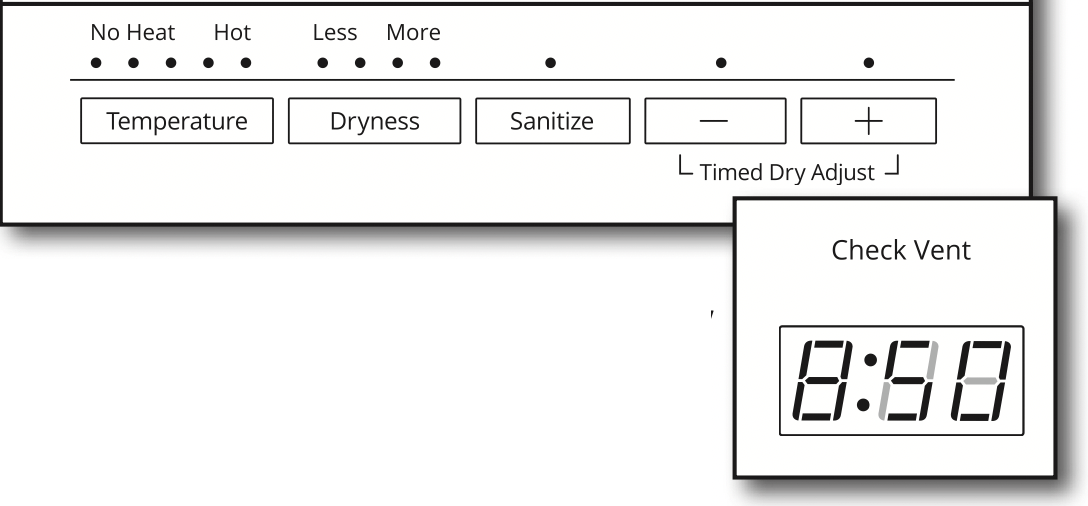
You may adjust different settings, depending on what you are drying and how you are going to dry the items. Selecting Sanitize will override all other modifiers. See the “Cycle Guide” for detailed information.
NOTE: Not all options and modifiers are available with all cycles. - Select any additional options

Add additional options such as Drum Light, Wrinkle Shield™ , Signal, and/or Damp Dry Signal by touching that option. If you will be unable to remove the load promptly, select Wrinkle Shield ™ before touching START/PAUSE.
NOTE: Not all options and settings are available with all cycles. - Touch and hold START/PAUSE to begin cycle
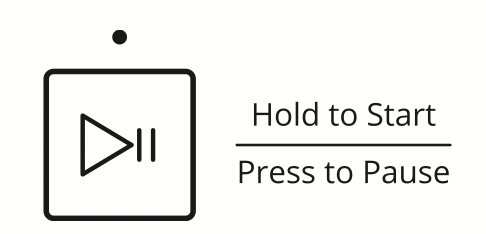
Touch and hold START/PAUSE to begin the cycle. - Remove garments promptly after cycle is finished

Promptly remove garments after cycle has completed to reduce wrinkling.
Changing the Automatic Cycle settings to increase or decrease drying time
If all your loads on all Automatic cycles are consistently less dry or more dry than you would like, you may change the default settings to increase or decrease the default dryness level.
Your automatic drying settings can be adjusted to adapt to different installations, environmental conditions, or personal preference. This change is retained and will affect all of your Automatic cycles, not just the current cycle/load. There are five drying settings, which are displayed using the LED display:
0 Much wetter clothes, 30% less drying time.
1 Slightly wetter clothes, 15% less drying time.
2 Factory preset dryness level.
3. Slightly drier clothes, 15% more drying time.
4 Much drier clothes, 30% more drying time.
To change the drying settings:
- Before starting a cycle, touch and hold DRYNESS for 6 seconds.
- Touch DRYNESS to select the dryness level shown in the time display: 0, 1, 2, 3, or 4.
- Touch START/PAUSE to save the new dryness level setting.
NOTE: The settings cannot be changed while the dryer is running or paused. The dryer must be in standby mode (power is off) to adjust the default settings.
Dryer Care
CLEANING THE DRYER LOCATION
Keep dryer area clear and free from items that would block the airflow for proper dryer operation. This includes clearing piles of laundry in front of the dryer.
WARNING - Explosion Hazard:
- Keep flammable materials and vapors, such as gasoline, away from dryer.
- Place dryer at least 18 inches (460mm) above the floor for a garge installation.
- Failure to follow these instructions can result in death, explosion, or fire.
CLEANING THE DRYER INTERIOR
To clean dryer drum:
- Use a mild hand dish detergent mixed at a low concentration with very warm water, and rub with a soft cloth.
- Rinse well with a wet sponge or towel.
- Tumble a load of clean clothes or towels to dry drum
OR
Use a microfiber cloth and hot water in a spray bottle to clean the drum and a second microfiber towel to dry.
NOTE: Garments that contain unstable dyes, such as denim blue jeans or brightly colored cotton items, may discolor the rear of the dryer interior. These stains are not harmful to your dryer and will not stain future loads of clothes. Dry unstable dye items inside out to avoid transfer of dye.
REMOVING ACCUMULATED LINT
From inside the dryer cabinet
Lint should be removed every two years, or more often, depending on dryer usage. Cleaning should be done by a qualified appliance servicer or ventilation system cleaner.
From the exhaust vent
Lint should be removed every two years, or more often, depending on dryer usage.
CLEANING THE LINT SCREEN
Every load cleaning The lint screen is located in the bottom of the dryer. A screen blocked by lint can increase drying time.
To clean:
- Pull the lint screen out of its holder. Roll lint off the screen with your fingers. Do not rinse or wash screen to remove lint. Wet lint is hard to remove.
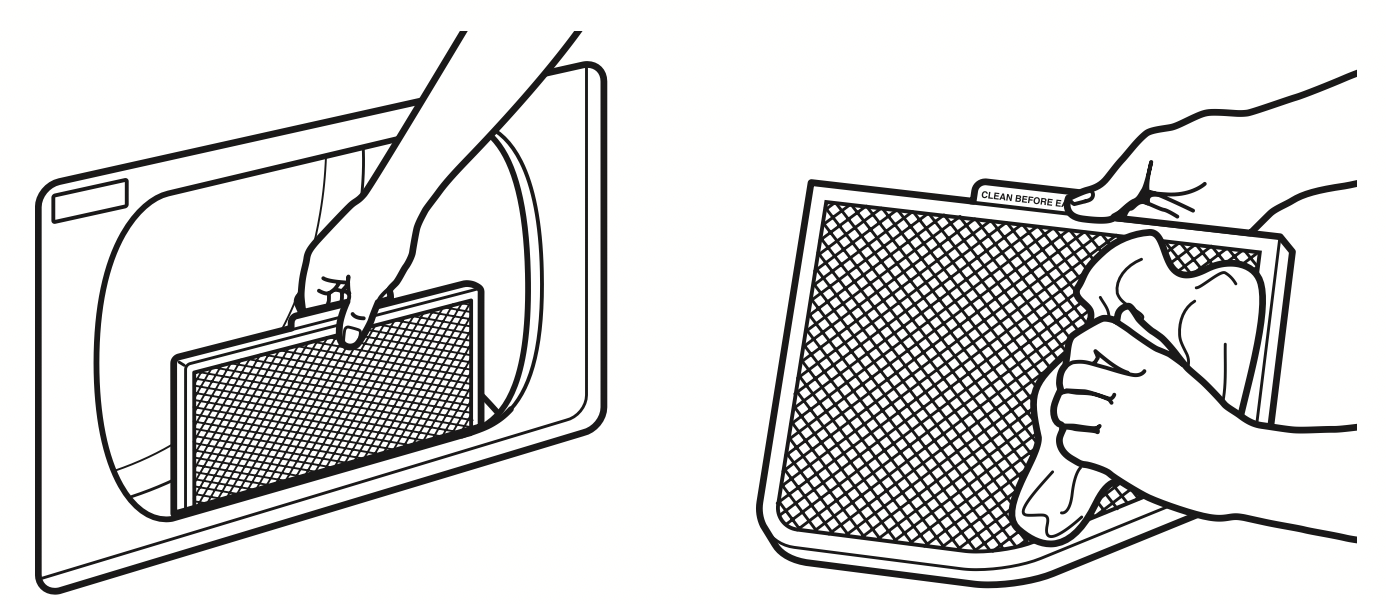
- Push the lint screen firmly back into place.
IMPORTANT:
- Do not run the dryer with the lint screen loose, damaged, blocked, or missing. Doing so can cause overheating and damage to both the dryer and fabrics.
- If lint falls off the screen into the dryer during removal, check the exhaust hood and remove the lint.
See the “Venting Requirements” section in the Installation Instructions.
As needed cleaning
Laundry detergent and fabric softener residue can build up on the lint screen. This buildup can cause longer drying times for your clothes, or cause the dryer to stop before your load is completely dry. The screen is probably clogged if lint falls off while the screen is in the dryer.
Clean the lint screen with a nylon brush every 6 months, or more frequently, if it becomes clogged due to a residue buildup.
To wash:
- Roll lint off the screen with your fingers.
- Wet both sides of lint screen with hot water.
- Wet a nylon brush with hot water and liquid detergent. Scrub lint screen with the brush to remove residue buildup.
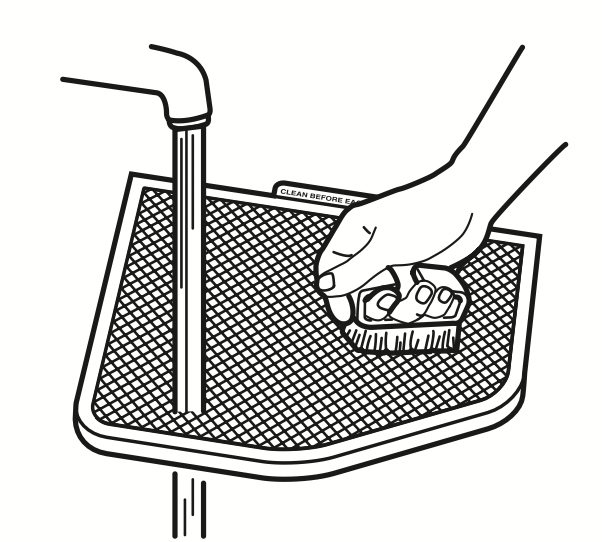
- Rinse screen with hot water.
- Thoroughly dry lint screen with a clean towel.
Reinstall screen in dryer.
NON-USE, STORAGE, AND MOVING CARE
Non-use or storage care
Operate your dryer only when you are at home. If you will be on vacation or not using your dryer for an extended period of time, you should:
- Unplug dryer or disconnect power.
- Clean lint screen. See the “Cleaning the Lint Screen” section.
Moving care
For power supply cord-connected dryers:
- Unplug the power supply cord.
- Gas models only: Close shut-off valve in gas supply line.
- Gas models only: Disconnect gas supply line pipe and remove fittings attached to dryer pipe.
- Gas models only: Cap the open fuel supply line.
- Make sure leveling legs are secure in dryer base.
- Use tape to secure dryer door.
WARNING - Electrical Shock Hazard
- Disconnect power before servicing.
- Replace all parts and panels before operating.
- Failure to do so can result in death or electrical shock.
For direct-wired dryers:
- Disconnect power.
- Disconnect wiring from dryer and secure wire ends.
- Make sure leveling legs are secure in dryer base.
- Use tape to secure dryer door.
Reinstalling the dryer
Follow the Installation Instructions to locate, level, and connect the dryer.
CHANGING THE DRUM LIGHT
- Unplug dryer or disconnect power.
- Open the dryer door. Locate the light bulb cover on the back wall of the dryer. Using a 1/4" (6 mm) nut driver or socket wrench, remove the screw located in the lower right-hand corner of the cover. Remove the cover.

- Turn bulb counterclockwise. Replace the bulb with a 10-watt appliance bulb only. Replace the cover and secure with the screw.
- Plug into a grounded outlet or reconnect power.
Troubleshooting
|
If you experience |
Possible Causes |
Solution |
|
Dryer Operation |
||
|
Dryer will not run |
Door not closed completely. |
Make sure the dryer door is closed completely. |
|
START/PAUSE not touched firmly or held long enough. |
Touch and hold START/PAUSE for 2-5 seconds. |
|
|
Household fuse is blown, circuit breaker has tripped, or dryer is not plugged in. |
There may be two household fuses or circuit breakers for the dryer. Check that both fuses are intact and tight, or that both circuit breakers have not tripped. Replace the fuses or reset the circuit breaker. If the problem continues, call an electrician. |
|
|
Incorrect power supply. |
Electric dryers require a 240-volt or a 208-volt power supply. Check with a qualified electrician. |
|
|
Wrong type of fuse. |
Use a time-delay fuse. |
|
|
Dryer will not heat |
Household fuse is blown or circuit breaker has tripped. |
The drum may be turning, but you may not have heat. Electric dryers use two household fuses or circuit breakers. Replace the fuses or reset the circuit breaker. If the problem continues, call an electrician. |
|
Incorrect power supply. |
Electric dryers require a 240-volt or a 208-volt power supply. Check with a qualified electrician. |
|
|
The gas supply line valve is not open. |
For gas dryers, make sure that the valve on the gas supply line is open. |
|
|
Unusual Noise |
||
|
Thumping noise |
Dryer hasn’t been used in a while. |
This is normal. The thumping sound should diminish after a few minutes of use. |
|
Rattling or vibrating noise |
A small object caught between the edges of dryer drum. |
Check the front and rear edges of the drum for small objects. Clean out pockets before laundering. |
|
Dryer isn’t properly leveled. |
The dryer may vibrate if not properly installed. See the Installation Instructions. All four dryer feet should be in firm contact with the floor. |
|
|
Clothing is balled up in dryer. |
When balled up, the load will bounce, causing the dryer to vibrate. Separate the load items and restart the dryer. |
|
|
Clicking noise |
Gas valve operating. |
On gas dryers, you may hear the gas valve clicking as it opens and closes. This is normal. |
|
Dryer Results |
||
|
Clothes are not drying satisfactorily, clothes are balling or tangling, or drying times are too long |
Lint screen is clogged with lint. |
Clean lint screen before each load. |
|
The exhaust vent or outside exhaust hood is clogged with lint, restricting air movement. |
Run the dryer for 5–10 minutes. Hold your hand under the outside exhaust hood to check air movement. If you do not feel air movement, clean exhaust system of lint or replace exhaust vent with heavy metal or flexible metal vent. See the Installation Instructions. |
|
|
The exhaust vent is not the correct length. |
Check that the exhaust vent is not too long or has too many turns. Long venting will increase drying times. See the Installation Instructions. |
|
|
The exhaust vent diameter is not the correct size. |
Use 4" (102 mm) diameter vent material. |
|
|
The dryer is not level. |
Clothes not contacting the moisture sensors during automatic cycles. See “Level Dryer” in the Installation Instructions. |
|
|
The No Heat temperature setting has been selected. |
Select the correct temperature for the types of garments being dried. See the “Cycle Guide” chart. |
|
|
The load is too large and heavy to dry quickly. |
Separate the load to tumble freely. |
|
|
Fabric softener sheets are blocking the grille. |
Check that the air outlet grille is not blocked by a fabric softener sheet. Use only one fabric softener sheet, and use it only once. |
|
|
The dryer is located in a room with temperature below 45ºF(7ºC). |
Proper operation of dryer cycles requires temperatures above 45ºF (7ºC). |
|
|
The dryer is located in a closet. |
Closet doors must have ventilation openings at the top and bottom of the door. The front of the dryer requires a minimum of 1" (25 mm) of air space, and, for most installations, the rear of the dryer requires 6" (152 mm). See the Installation Instructions. |
|
|
Clothes are getting over or under dried |
The automatic cycle settings are too high or too low. |
See “Changing the automatic cycle settings to increase or decrease drying time” to adjust your dryer settings. |
|
Cycle time is too short |
The load may not be contacting the sensor strips on automatic cycles. |
Level the dryer. See the Installation Instructions. All four dryer feet should be in firm contact with the floor. |
|
The automatic cycle is ending early. |
Change the dryness level setting on automatic cycles. Increasing or decreasing the dryness level will change the amount of drying time in a cycle. If loads are consistently ending too early, see also “Changing the automatic cycle settings to increase or decrease drying time.” |
|
|
Lint on load |
Lint screen is clogged with lint. |
Clean lint screen before each load. |
|
Stains on load |
Improper use of fabric softener. |
Add dryer fabric softener sheets at the beginning of the cycle. Fabric softener sheets added to a partially dried load can stain your garments. |
|
Stains on drum |
Loose dyes in clothes. |
Drum stains are caused by dyes in clothing (usually blue jeans). These will not transfer toother clothing. |
|
Loads are wrinkled |
The load was not removed from dryer at the end of the cycle. |
Select the Wrinkle Shield option to tumble the load without heat to avoid wrinkling. |
|
The dryer was tightly packed. |
Dry smaller loads that can tumble freely. Results may also vary depending on fabric type. |
|
|
Odors |
Recent painting, staining, or varnishing in the area where your dryer is located. |
Ventilate the area. When the odors or fumes are gone from the area, rewash and dry the clothing. |
|
Load too hot |
Load removed before cool down portion of cycle complete. |
Allow the dryer to complete the cool down portion of the cycle before removing the load. |
|
Using Timed Dry cycle with a high temperature setting. |
Select an automatic cycle with a lower heat setting to avoid over drying the load. |
|
|
Dryer Displaying Code Message or Indicator Is Lit |
||
|
“PF” (power failure) |
The drying cycle has been interrupted by a power failure. |
Touch and hold START/PAUSE to restart the dryer cycle or touch power to clear the display. |
|
“L2” Diagnostic Code (low or no line voltage condition) |
There may be a problem with your home power supply, keeping the dryer’s heater from turning on. |
The dryer will continue to run when this diagnostic code is present. Touch any pad to clear the code from the display and return to the estimated time remaining. NOTE: This error will only show during the initial installation. Try the following:
If the message persists, consult a qualified electrician. |
|
“F# E#” (F1 E1, F3 E1, etc.) variable service codes. |
The dryer is in need of service. |
If a code beginning with an “F” appears in the display, alternating between F# and E#, the dryer control has detected a problem that requires service. Call for service. |
